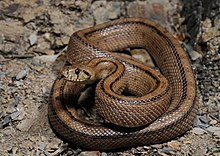Field Guide/Snakes/Spain
Ladder Snake
[edit | edit source]
The ladder snake (Rhinechis scalaris) is a snake from the family Colubridae.
What does it look like?
[edit | edit source]The ladder snake is a big and robust snake with a relatively short tail. It has got a yellowish colour on its belly and the shapes of a ladder on its back that is why it is called the ladder snake. It is more than 72 centimeters long.
Where is it located?
[edit | edit source]The ladder snake is located in mostly all the Iberian Peninsula except some regions in the north because it is too cold for them. In some parts of France there are some specimens. This species has also been introduced in the island of Menorca.
Where does it live?
[edit | edit source]The ladder snake normally lives in meadows, near rivers and forests. It is also abundant in pasture land and cultivating land if there are some bushes near there. It lives where the small mammals such as rodents live.
Is it going to extinct?
[edit | edit source]The ladder snake is considered to be a non threatened species although a lot of them are killed because they are run over by cars and we destroy their habitats.
What does it eat?
[edit | edit source]95% of the diet of the ladder snake is small rodents such as mice and it also eats birds if it can catch them. It hunts its prey in late afternoon and in the evening. The most impressive thing is that it can climb up to trees or bushes to eat the birds in the nest.
How does it reproduce?
[edit | edit source]The ladder snake is an oviparous species so it lays eggs to reproduce. The matings happen mainly in spring. The female lays few and big eggs in its put that happens in July. The eggs hatch very late, in the month of October. The adult males and females reproduce every single year.
Is this predator preyed?
[edit | edit source]The ladder snake has many enemies in the Iberian Peninsula, the most important is the Short-toed Snake Eagle. Many specimens have been found with a broken tail.
How does it behave
[edit | edit source]There have been found active species in the months of winter in the south of the Iberian Peninsula. During the mating season people see and capture only males because these move more in the mating season than the females. It is a nocturnal species so it sleeps in the day and it hunts at night.